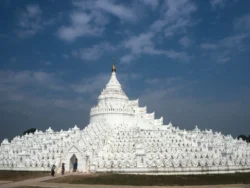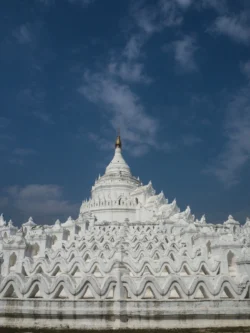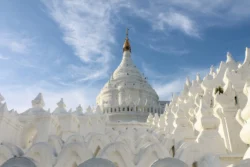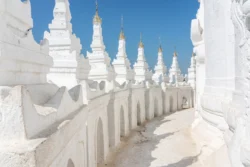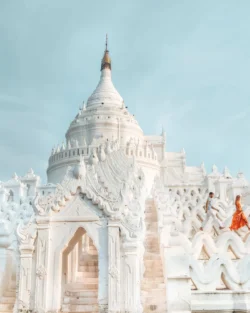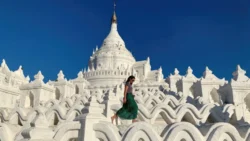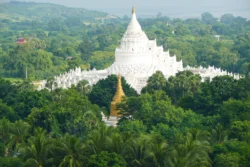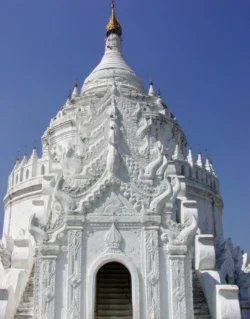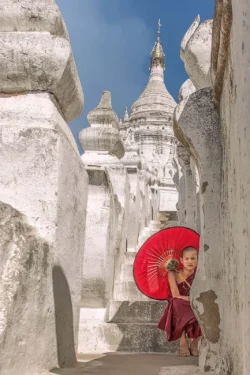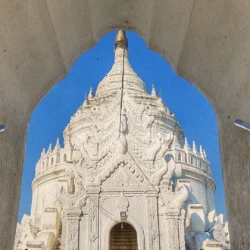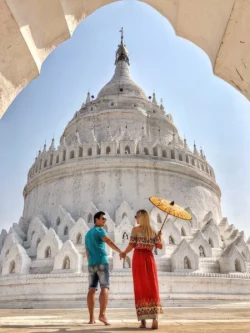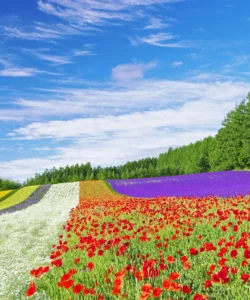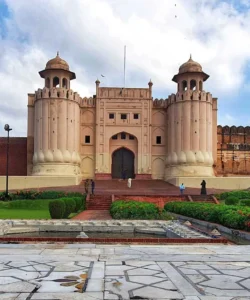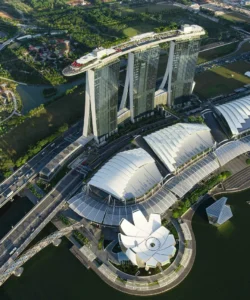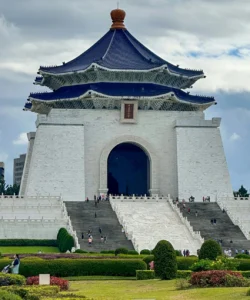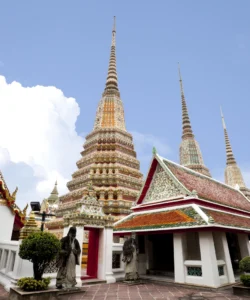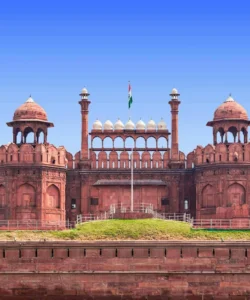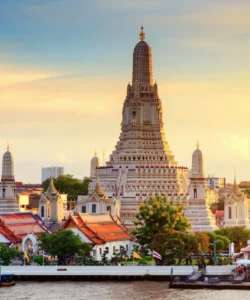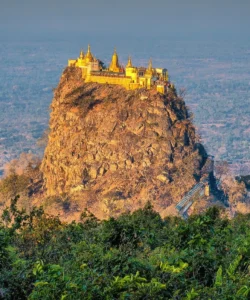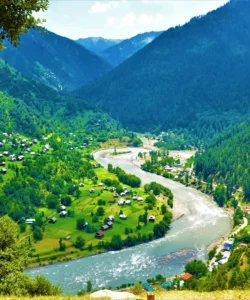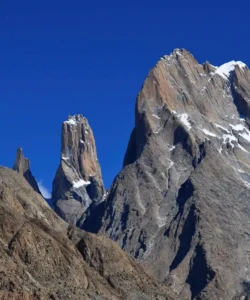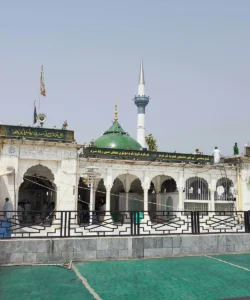The Hsinbyume Pagoda, also known as Myatheindan Pagoda, is an enchanting and distinctive Buddhist monument located near Mandalay, Myanmar. Its striking all-white exterior and unique architectural design, inspired by mythical cosmology, make it a true wonder that stands apart from other pagodas in the region.
Name: Hsinbyume Pagoda (Burmese: ဆင်ဖြူမယ်စေတီ, meaning “White Elephant Princess Pagoda”; also Myatheindan Pagoda, မြသိန်းတန်စေတီ, meaning “One Hundred Thousand Emerald Pagoda”)
Address: Mingun, Sagaing Region, Myanmar. It is situated on the western bank of the Ayeyarwady River, approximately 11 kilometers (6.8 miles) northwest of Mandalay, near the Mingun Pahtodawgyi (unfinished pagoda) and the Mingun Bell.
How to Get There:
Hsinbyume Pagoda is a key attraction in the Mingun area, a popular day trip from Mandalay.
- By Air: The closest airport is Mandalay International Airport (MDL). From the airport, you would take a taxi to Mandalay city, and then proceed to Mingun.
- From Mandalay to Mingun:
- By River (Recommended & Scenic): The most popular and traditional way is to take a ferry or public boat from Mandalay’s Gawwein Jetty to Mingun. The scenic boat trip on the Ayeyarwady River typically takes about 1 hour each way and offers glimpses of riverside life.
- By Road: Taxis or private cars can be hired from Mandalay directly to Mingun (approx. 30-40 minutes drive). This offers more flexibility, especially for combining with other nearby sites like Sagaing. Motorbike rentals are also an option for experienced riders.
- Within Mingun: Once in Mingun, Hsinbyume Pagoda is within walking distance from the ferry landing and the Mingun Pahtodawgyi. You can also hire a local ox cart for a charming, short ride.
- Entrance Fee: Entry to Hsinbyume Pagoda usually requires purchasing a ticket for the Mingun archaeological zone (approximately US$5 or 5,000 Kyats), which also grants access to other sites in Mingun like the Mingun Pahtodawgyi and Mingun Bell.
- Dress Code: As a sacred Buddhist site, visitors are required to dress modestly (shoulders and knees covered). Footwear must be removed before entering the pagoda grounds.
Landscape and Architecture:
Hsinbyume Pagoda’s architecture is unique among Burmese pagodas, designed to represent a mythical cosmic mountain.
- All-White Exterior: The pagoda is strikingly all-white, from its base to its central stupa. This pure white color symbolizes purity and stands out beautifully against the blue sky, especially after its periodic repainting (reportedly every two years).
- Mythical Mount Meru Inspiration: Its most distinctive design feature is that it is modeled on the physical description of the Sulamani Pagoda on Mount Meru, the sacred mountain at the center of the Buddhist and Hindu universe.
- Seven Concentric Terraces: The pagoda is built with seven undulating, concentric terraces (or “wave-like” terraces) that lead up to the central stupa. These seven terraces represent the seven mythical mountain ranges (or “seven oceans”) that encircle Mount Meru.
- Mythological Creatures: Niches along these terraces contain small statues of mythological creatures, including various nats (spirits), ogres, and naga (serpents), drawing from Burmese and Buddhist folklore.
- Central Stupa: At the very top, the central stupa is inspired by the mythical Chulamanee Pagoda, which is traditionally located on top of Mount Meru. The stupa itself houses a Buddha image.
- Open Stairways: Open stairways lead visitors up through the seven terraces to the top platform, allowing for exploration of the unique wavy design and providing panoramic views.
- Commemorative Purpose: The pagoda was built in 1816 by Prince Bagyidaw (who later became King Bagyidaw) as a poignant memorial to his first consort and cousin, Princess Hsinbyume (“White Elephant Princess”), who tragically died in childbirth nearby in 1812.
- Earthquake Damage and Restoration: The pagoda suffered severe damage during a major earthquake in 1839 (which also affected the Mingun Pahtodawgyi) but was later restored in 1874 by King Mindon, the penultimate king of Myanmar. While there have been reports of damage from a more recent earthquake in March 2025, the pagoda has undergone previous successful restorations.
- Riverside Setting: Its location on the banks of the Ayeyarwady River offers beautiful views, especially from the top, providing a scenic context for its unique architecture.
What Makes It Famous:
- Unique Wavy Architecture: Its distinctive all-white, wave-like terraces, inspired by Mount Meru, make it architecturally unique and unlike any other pagoda in Myanmar. It’s often likened to a “white wedding cake” or “rippling waves.”
- “Taj Mahal of the Ayeyarwady”: Due to its commemorative purpose (built for a beloved princess by her husband) and its beautiful design, it has earned the nickname “The Taj Mahal of the Ayeyarwady River,” drawing a comparison to the famous Indian monument of love.
- Photogenic Beauty: Its pure white exterior, especially against a blue sky, makes it an exceptionally photogenic site, very popular on social media platforms for its ethereal and artistic appeal.
- Spiritual and Mythological Symbolism: Its direct representation of Mount Meru and the cosmic Buddhist universe offers a deep layer of spiritual and mythological meaning that is explicitly integrated into its design.
- Associated with Mingun Landmarks: It is often visited in conjunction with other famous Mingun attractions, including the unfinished Mingun Pahtodawgyi (a massive brick stupa intended to be the world’s largest but left incomplete due to an ominous prophecy) and the Mingun Bell (the world’s third-largest ringing bell).
Differences from Some Other Wonders:
- Cosmic Mountain Design: Unlike the largely solid, bell-shaped stupas of Shwedagon Pagoda or the various traditional temples of Bagan, Hsinbyume Pagoda’s fame is singularly tied to its explicit and unique design as a representation of Mount Meru and its surrounding mountain ranges, conveyed through its seven concentric, wavy terraces. This cosmological symbolism is central to its architectural form.
- All-White Exterior: While other pagodas are golden (Shwedagon) or made of brick (Bagan), Hsinbyume’s pure white exterior sets it apart visually and symbolizes purity, contrasting with the vibrant colors or gilded finishes of other religious sites.
- Focus on Exterior Aesthetic: While you can climb it, its primary fame often derives from its stunning and unique exterior aesthetic, making it a photographic marvel, perhaps more so than its interior.
- Commemorative Love Story: Similar to the Taj Mahal, Hsinbyume Pagoda has a direct love story behind its construction, built in memory of a deceased royal consort, which gives it a romantic narrative distinct from most other pagodas.
- Located within a Smaller Archaeological Site: While a prominent monument, it’s part of the Mingun archaeological zone, which is a collection of a few major sites, rather than being a single, sprawling temple complex (like Angkor Wat) or thousands of temples on a plain (like Bagan).
- No Sacred Relics Claimed (as primary fame): While it enshrines a Buddha image, its fame is not primarily driven by the belief that it holds sacred relics on the scale or significance claimed by the Shwedagon Pagoda.
Hsinbyume Pagoda Photos:

